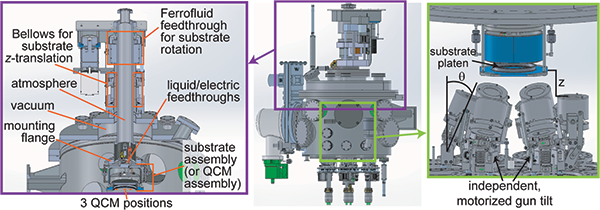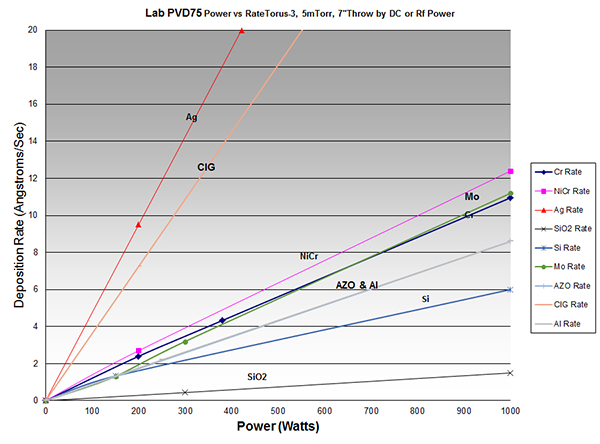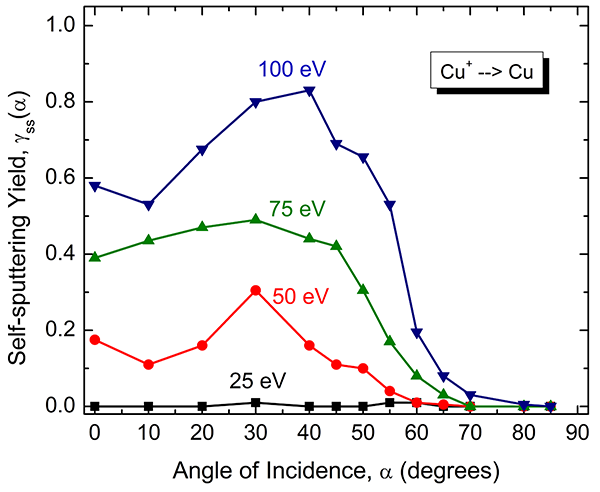Combinatorial Magnetron Sputtering (CMS) has distinguished itself as a viable tool for the rapid development of vast libraries of complex materials. Researchers at the Joint Center for Artificial Photosynthesis, California Institute of Technology (Cal Tech) and the Kurt J. Lesker Company® (KJLC®) [1] have recently published work on Combinatorial Magnetron Sputtering (CMS) using a novel robotically controlled thin film deposition cathode tilt and substrate manipulation mechanism. Combinations of metal alloys, mixed metal oxides and nitrides have been demonstrated with the system as a basis for a predictive model developed by Cal Tech to streamline the design of new materials for certain critical applications.

Fig 1. Schematic of the Kurt J. Lesker CMS-24 physical vapor deposition system: (center) external view of the entire chamber, (left) inset showing a cross-section view of the substrate platen with rotation and translation motion and a feedthrough flange onto which either the substrate platen or QCM platen can be mounted, (right) inset showing the in-vacuum view of the 6 on-axis magnetron sources and substrate platen.
The principle goal of combinatorial research, the composition-structure-property relationships in complex material sets, requires that techniques be established which can cope with very large amounts of information, more than 5,000 samples per wafer, for example, and quickly identify property 'fields' in which to perform detailed characterization.. For practicality, any advanced sample generation process must be integrated with high throughput characterization by X-ray diffraction , X-ray fluorescence [2] or other relevant tests, which can effectively screen thousands of compounds in a very short period of time. In an earlier publication, the authors have reported on an advanced synchrotron-based characterization technique which delivers a combined X-ray diffraction and X-ray fluorescence measurement every 18 seconds, enabling the characterization of about 5,000 samples in a 24 hour period.
A Review of Combinatorial Synthesis
A comprehensive review of high throughput combinatorial synthesis has been prepared by authors at NIST, the University of Maryland and the University of South Carolina [6]. In this publication from 2013, the application of combinatorial approaches to the discovery of new electronic, ferroelectric, piezoelectric, multiferroic and magnetic materials is discussed. The authors also identify similar applications in optics and energy-related materials.
Earlier publications based on the use of sputter deposition to develop new libraries include work done by researchers Lawrence Berkeley Laboratory [3] on materials which exhibit Colossal Magnetoresistance (CMR). The authors present results on a library of 128 distinct compositions of Y -, La - , Ba - , Sr-, Ca - , and Co containing films such as La0.60YCa0.33MnOx and Nd0.7Sr0.33MnO3-x (1995). Sequential radio-frequency sputter deposition was combined with post deposition heat treatment.
One of the earlier commercial pioneers of combinatorial synthesis utilizing thin films, Symyx Technologies [4], demonstrated a library of 25,000 oxide compositions based on Y -, Al - , La - , Eu - , and V, such as Y0.845Al0.070La0.060Eu0.025VO4 with very high quantum efficiency similar to commercial red phosphors existing at the time (1997). Other luminescent inorganic oxides were developed around the Sr-Ce-O systems using similar automated thin film physical vapor deposition methods followed by prolonged heat treatment to form single-phase compositions [5].
Thin Film Deposition Process Variables
The recent work by Cal Tech and KJLC was performed using a specially modified sputtering system manufactured by the Kurt J. Lesker Company (Fig. 1 and Fig. 2). Thin film deposition techniques, with their numerous process variables, provide a perfect platform for the synthesis of comprehensive material alloy libraries with a broad variation in compositions achievable at the molecular level. For example, in thin film deposition via sputtering, the tuning of various films' properties can be achieved through variations in (1) source voltage, (2) gas pressure, (3) reactive gases (4) and deposition geometry.
The system used by Cal Tech was engineered to support six robotically configured sputter cathodes where the cathode-to-substrate distance and incident angle could be varied to effect composition. This advanced capability enabled the Cal Tech researchers to achieve broad swings in compositional ranges so that ternary libraries with 8% to 82% of each element could be simultaneously synthesized on a single 100 mm wafer.
The robotic cathode control system enables detailed studies of the influence of deposition source angle and throw distance on film composition. 3D deposition profiling is used to expose process subtleties inherent in close-quarter, multiple cathode systems during co-sputtering. The understanding of these effects enables a more refined predictive model for new compositions, making it part of a comprehensive technique for the development of large materials libraries.
This work alludes to some of the complexities of localized deposition conditions caused by the interaction of six active cathodes during co-sputtering. The experimental mapping performed in the Cal Tech work provides direct observational data of these subtleties including the interactions of various magnetic fields, self re-sputtering of the individual precursors, the effects of various incident angles and molecular sticking co-efficients.

Figure 2. Combinatorial Magnetron Sputtering system which combines a PVD-75 with a CMS-24 and load lock with interchangeable top plate and substrate manipulation system.
Deposition System Description
For this project, The Kurt J. Lesker Company manufactured a dual-chamber vacuum system that coupled a PVD 75 platform with a CMS-24 system. Samples are moved between the cassette load lock and the two chambers using a robotically controlled radial distribution system. The CMS-24 deposition chamber was equipped with six 2" diameter, on-axis, magnetron sputter cathodes with full in-situ computer control of tilt angle with respect to the substrate, a sample holder on a translational and rotational stage (with serpentine substrate heater capable of high-temperature deposition), a high temperature evaporation stage and three quartz crystal monitors (Fig. 3).

Figure 3. Partial view inside the deposition chamber showing three of the six cathodes, outfitted with compact dome shutters to minimize cross contamination and footprint, and the high temperature evaporation source (center).
The Z motion control of the distance between the substrate and the sputter cathodes is enabled by a linear bellows in the substrate fixture.
Details of the Process
The deposition system was designed with two interchangeable chamber lids. One is a dedicated characterization array of quartz crystal monitors (QCMs) mounted on an automated rotational stage and the other is a lid which accommodates the substrate holder with a heater and manipulation system. In order to map the various deposition profiles of the precursor materials the flange equipped with the QCMs is installed on the system. The QCMs are positioned on the flange so that they map an area equivalent to 100mm substrates.
Sputtering from a 2" diameter copper target at 60 watts DC, deposition rates at the three QCMs were measured at four distinct tilt angels (10°, 15°, 20° and 25°) and seven z-heights ranging from 3.5 cm to 12.6 cm. In addition, for each z-height and tilt angle, the QCM array was also rotated from 0° to 345° in 15° increments resulting in a total of 2,016 unique deposition rate measurements.

Fig 4. Three-dimensional deposition profiles at various source tilts of 10°, 15°, 20° and 25°. The false color scale is common to all figures and maps the deposition rates (relative to the maximum) of Cu at 60 W DC power, 360 V DC bias, and 0.8 Pa Ar.
Based on the deposition rate information derived from the initial run on the QCMs predictive models of metal alloy, mixed metal oxides and metal nitrides were developed. The system can be refitted with the substrate holder/manipulation lid and the deposition repeated with two or more precursor targets. Compositional results can be determined using the methods described in Refs. 2 and 6 or other methods to include electrical, optical properties in either high-throughput or low-throughput tests.
The Benefits of This Innovation
In contrast to traditional thin film combinatorial synthesis, the Cal Tech researchers have developed a comprehensive model of the interweaving of sputtered molecules from several discrete sources which enables a strong predictive resource for designers of new compositional libraries. Sequential or layer-by-layer deposition often requires considerable post-deposition processing, such as heat treatments, in order to fully form phase pure, or stable, compositions. These post-deposition treatments often require considerable process development resources to identify the appropriate temperature/time profiles, often in non-air atmospheres, in order to optimize the number of phase pure, or stable, coupons on a substrate. The predictive modeling that resulted from the work, which included both the novel deposition of the thin film library materials coupled with advanced rapid characterization methods, represents a substantial reduction in the cycle time required to identify new materials compositions.

Fig 5. Deposition rates of various materials by DC and RF sputtering. Compiled from KJLC applications lab data
Deposition rates vary widely based on electrical conductivity and sputtering method. Figure 5 compares rates for several materials, highlighting the large difference in rates for good electrical conductors like silver, which can be sputtered with DC, and classic insulators, like silicon dioxide, which must be sputtered by RF methods. This large variation in rates further complicates the development of useful predictive models.
The Cal Tech researchers have published previously on their development of high throughput methodologies for the screening and characterization of vast materials arrays [7]. With the number of unique coupons to be tested often exceeding 5,000, their approach is two-tiered. An initial rapid scan is used to identify regions or phase pure or stable compositions, followed by low throughput techniques which drill down into the properties within subsets. In this work an algorithm was developed for the down-selection of samples from higher throughput screening techniques to more traditional techniques once compositions of particular interest were identified. In this work the authors demonstrated the development of a composition-property map, focused on catalytic activity, for a library of 5,429 compounds within the (Ni – Fe – Co – Ce) Ox space.
High materials utilization is another benefit of CMS because very little target material is consumed in the generation of large compositional libraries. Mere grams of materials are expended using the sputtered film approach, verses kilos of materials required from bulk combinatorial approaches.
To compare the CMS process to traditional approaches, in an unrelated project, researchers at KJLC recently utilized a serial materials development approach to identify ionic conductors in ceramic materials which could be electrically conductive in bulk form but an electrical insulator as a thin film. The approach, done in collaboration with scientists from ITN Energy Systems, involved the fabrication of a variety of bulk metal oxides, based on yttria-stabilized zirconia, that were either doped, oxygen starved or both doped and oxygen starved. Processing of the array of ceramic powder compositions and subsequent sintering, in air or in some cases in vacuum, took many weeks. Characterization and down selection also took time and the 'winners' were then processed into 3" sputter targets for test depositions at ITN. The entire cycle took several months and resulted in a very limited number of process conditions and samples being considered.
In contrast, the entire cycle time for one of the new libraries developed using CMS, coupled with the rapid characterization process developed by Cal Tech can be achieved in only a few days or weeks.
Optimized Thin Film Deposition Rates
An additional advantage of the thin film deposition data taken to feed the Cal Tech combinatorial model was the identification of optimal cathode-to-substrate geometry (tilt angle and Z-distance) to maximize high deposition rates. Figure 4 shows an example of the deposition rate data collected as the fundamental input for the model developed by Cal Tech. This results in a clearer understanding of the relationship of X-Y-Z position in the glow discharge from a particular cathode to the deposition rate of specific materials. Film deposition rates are measured for more than 2,000 unique cathode/substrate geometries revealing the sweet spot or optimal tilt and distance for each material and cathode.

Fig 6. Deposition rates of Cu at 60 W DC and 0.8 Pa Ar from three sources placed at an in-plane angle of 120° relative to each other. The deposition geometry is chosen to maximize dynamic range of deposition rates from (Omega = 15° and z = 3.5 cm). The resulting compositions of the 49 measurement locations are shown in the right-most figure, demonstrating composition variation from 8% to 82% for each element.
A wide range of compositional variations can also be achieved, such as broad ternary composition coverage in the 8-82% range (Fig. 6). The deposition profiling technique also identifies geometries for synthesizing composition libraries with doping or alloying at sub-1% levels, which could open the door to additional discoveries in the areas of luminescent, giant magneto resistance and energy storage where small amounts of doping can cause dramatic changes in materials properties.
Advantages, Complications and Implications
Traditional layer-by-layer combinatorial sputtering approaches often require protracted post-deposition heat treatments to achieve complete diffusion of the materials deposited in a stack into a homogeneous structure. In the Cal Tech work molecular level mixing is achieved in the glow discharge of multiple cathodes during co-deposition. The 3D mixing of precursors achieved during co-sputtering insures that diffusion path lengths will be minimized and post-deposition efforts to create single phase materials reduced. The increased homogeneity achieved in this mixing of precursor molecules may minimize the amount and intensity of any post-deposition processing.
There is, however, a drawback to the co-deposition approach as some degree of re-sputtering of precursors is unavoidable. The effective sticking co-efficient of an individual precursor may be altered during co-sputtering due to the additional, and unwelcomed, bombardment by high energy ions, from others in an array of six cathodes, on the substrate. In co-deposition, with energetic molecules impinging on the substrate from different angles and with different atomic masses, the alloying process is not completely efficient as some material simply is expelled or ablated from the growing film. This may create a considerable disconnect between what may be produced with a single sputter source and the results of a multi-cathode co-deposition. These effects can also be studied with the deposition profiling techniques, but such results have yet to be reported.
The relationship between impingement angle and re-sputtering has been studied. In work published by Anders et al at Lawrence Berkeley National Laboratory [9] the effect of the impingement angle of an incoming sputtered molecule on its self re-sputtering is examined. The authors report that, using nickel as an example, re-sputtering reached nearly 70% at incident angles in the range of 40 – 50° (at high energies) where the rate, at the same power, for an impingement angle of 90° (cathode directly facing the substrate) was only 30% at 100eV.
Reduction to Practice
Modeling is still, at a minimum, a two-stage process of co-deposition on multiple quartz crystal micro-balances, followed by detailed characterization, interpretation and modeling. Then there is a mechanical re-fit of the deposition system with actual substrates, a second deposition run and the empirical verification of the model via a second characterization sequence. A post-deposition heat treatment may also be required. With time and the development of multiple materials libraries, experience with the likely interactions between materials and the various deposition parameters enabled by this approach may help tune the cycle time required to develop a predictive model.
Additional factors that may need inclusion in a comprehensive predictive model may include the interaction of multiple magnetic fields, effects on the shape of the glow discharges of individual cathodes, re-sputtering and possible unusual wear on system components from distorted glow discharge regions which may now include parts of the sputter cathodes like the dark space shields and target hold down rings.

Figure 7. Effect of incidence angle on Self-Sputter Yield, (Anders, et al… [8])
Conclusions
Several areas of materials development including next generation storage applications for information and energy may require highly complex, multi-components materials ([9] Thin Film Batteries). For some applications, like energy storage in thin films, there is no Moore's Law for batteries [10] limiting future progress toward increased energy density to the discovery of new materials systems. CMS has been demonstrated as an effective route to generate thousands of materials compositions in a short period of time. Coupled with high-throughput characterization and screening approaches, CMS is a complicated but intriguing methodology for the fabrication and mapping of the vast compositional libraries.
The application of robotically controlled tilt angle capability to a family of sputter cathodes has broadened the spectrum and variety of materials compositions achievable from certain precursor sets. The intermolecular mixing achieved in thin films through co-sputtering of several precursor target materials may also reduce the post-deposition process development required to fully establish useable compositions from the large pallet of materials mixtures that result in CMS. In order to maintain or improve the pace of innovation in some critical areas advanced materials discovery strategies may have to be utilized and CMS has been demonstrated as a flexible and robust tool.
References
1. 'Combinatorial thin film composition mapping using three dimensional deposition profiles', Review of Scientific Instruments 86, 033904 (2015); doi: 10.1063/1.4914466
2. 'High-throughput synchrotron X-ray diffraction for combinatorial phase mapping', Journal of Synchrotron Radiation 21, 1262-1268 (2014); doi: 10.1107/S1600577514016488
3. 'A Class of Cobalt Oxide Magnetoresistance Materials Discovered with Combinatorial Synthesis'((http://search.proquest.com/openview/cf7ebc73b0b5b4f812d2ec4d64c6cf32/1?pq-origsite=gscholar)
4. 'A combinatorial approach to the discovery and optimization of luminescent materials', (http://www.nature.com/nature/journal/v389/n6654/full/389944a0.html)
5. 'X-ray powder structure of Sr2CeO4: a new luminescent material discovered by combinatorial chemistry', http://www.sciencedirect.com/science/article/pii/S0022286098004852
6. 'Applications of high throughput (combinatorial) methodologies to electronic, magnetic, optical, and energy related materials', Journal of Applied Physics 113, 231101 (2013); doi: 10.1063/1.4803530
7. 'Generating Information-Rich High-Throughput Experimental Materials Genomes using Functional Clustering via Multitree Genetic Programming and Information Theory', ACS Combinatorial Science 2015, 17 (4), pp 224-233; doi:10.1021/co5001579
8. 'Energetic deposition of metal ions: Observation of self-sputtering and limited sticking for off-normal angles of incidence,' Hongchen Wu, Andre Anders, submitted to Journal of Physics D: Applied Physics, Sept. 22, 2009
9. Juchuan Li, Cheng Ma, Miaofang Chi, Chengdu Liang, and Nancy J. Dudney, 'Solid electrolyte: the key for high-voltage lithium batteries,' Advanced Energy Materials, http://dx.doi.org/10.1002/aenm.201401408
10. 'No Moore's Law for Batteries,' Proceedings of the National Academy of Sciences, vol. 110 no. 14 > Fred Schlachter, 5273, doi: 10.1073/pnas.1302988110



